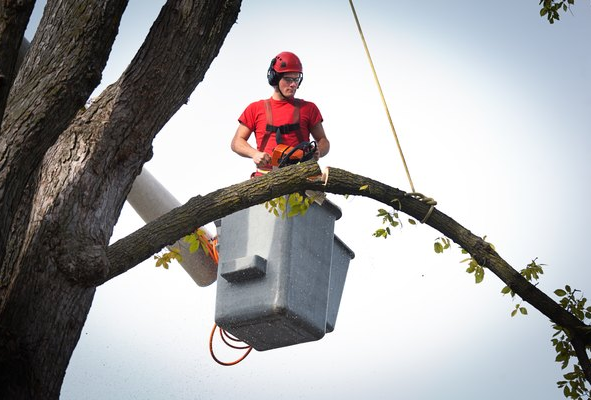Expert Silver Maple Emergency Tree Removal

Silver maple trees, known for their rapid growth and extensive root systems, can often present significant challenges, especially during emergencies. Their brittle wood makes them particularly vulnerable to storm damage, leading to dangerous situations where fallen branches or uprooted trees can threaten homes, power lines, and public safety. Expert tree removal services are essential in these critical moments to ensure a quick and safe resolution. Key Takeaways: Silver Maple Trees Pose Unique Risks in Emergencies: Due to their fast growth and brittle wood, silver maple trees are more likely to suffer damage during severe weather. Understanding these risks is critical to preventing severe property damage and ensuring quick action when emergencies arise. Importance of Professional Tree Removal: Certified arborists use specialized equipment and techniques to safely remove silver maple trees, minimizing risks to homes, power lines, and people. Speed and precision are crucial in mitigating further damage during emergency removals. Post-removal solutions Help Prevent Future Hazards: Stump grinding and replanting more resilient tree species after emergency removal can help prevent future issues. Expert services provide removal and long-term solutions to maintain property safety and aesthetics. Understanding the Need for Emergency Tree Removal Why Silver Maple Trees Are Common in Emergencies Fast-growing nature of silver maples Due to their speedy growth, silver maple trees are well-liked in many residential locations because they can quickly provide shade and have a pleasing appearance. However, their fast growth can also be problematic. As silver maples overgrow, their branches become large and heavy without developing the same strength and resilience as slower-growing species. This makes them more vulnerable to breaking during storms or under pressure. Brittle wood and susceptibility to storm damage One key reason silver maple trees often require emergency removal is the brittle nature of their wood. Unlike sturdier tree species, silver maple wood is fragile and prone to snapping under stress, particularly during high winds, heavy rainfall, or other severe weather events. This brittleness makes the trees frequently casual during storms, resulting in fallen limbs or entire trees needing immediate attention to prevent further damage. Root system vulnerabilities Silver maples also have relatively shallow root systems, which can weaken their stability, especially in wet or saturated soil. In times of heavy rain or flooding, these roots can become less secure, increasing the tree’s risk of falling. A weak root system and the top-heavy nature of fast-growing branches make silver maples particularly prone to toppling over during adverse conditions. Common Causes of Silver Maple Emergencies Severe weather: storms, lightning strikes, and high winds The most common cause of emergencies involving silver maples is severe weather. Storms, high winds, and lightning strikes can all significantly damage these trees. Their brittle branches will likely break off during such events, posing immediate risks to nearby structures and power lines. In some cases, entire trees may be uprooted, particularly if their shallow roots have been weakened by heavy rain or flooding. Root instability leading to tree falls Another frequent cause of silver maple emergencies is root instability. As these trees proliferate, their root systems often fail to anchor them properly, particularly in wet or loose soil conditions. When the ground becomes saturated after prolonged rainfall, the roots can lose their grip, leading to the entire tree falling. This can cause significant damage to properties, vehicles, and public infrastructure. Structural damage to homes or power lines When silver maple trees fall or lose large limbs, they threaten homes, power lines, and other structures. Falling branches can cause severe accidents and expensive repairs when they smash into cars, windows, and roofs. Additionally, fallen trees can bring down power lines, leading to outages and other electrical dangers that require urgent attention from emergency tree removal services. Safety Hazards Associated with Silver Maple Trees Potential Dangers in Emergency Situations Falling limbs and branches Due to their brittle wood, silver maple trees are particularly prone to shedding limbs and branches during storms or high winds. Falling limbs can happen suddenly, and depending on their size, they can cause severe injury to anyone nearby or significant property damage. The unpredictability of these incidents makes silver maples a hazard during emergencies, requiring swift action to prevent further risks. Damage to nearby structures In residential areas, silver maple trees often grow close to homes, garages, or other buildings. When a tree or large branch falls, the damage can range from broken windows and dented roofs to structural damage that compromises the integrity of the building. In some cases, branches that fall during a storm may also block driveways or streets, creating additional hazards and obstructions that require immediate removal. Risk to power lines and public utilities Silver maples are often planted near roads, and their wide-reaching branches can interfere with power lines. In emergencies, falling limbs or trees can reduce power lines, cutting electricity to homes and businesses. This poses a danger due to the loss of power and because downed lines can lead to fires or electrical hazards that may require emergency tree removal and utility repair teams to respond. Injuries caused by improper removal techniques If tree removal is attempted by someone without proper expertise or equipment, the risks increase dramatically. With their weak wood and heavy branches, silver maple trees require precise techniques to prevent limbs from falling unpredictably. Improper handling can lead to serious injury, such as falling branches or equipment malfunctions, so professional removal is always recommended. DIY tree removal can often worsen the situation, leading to more damage or personal injury. Health and Safety Protocols for Tree Removal Assessing the situation for risks Before beginning any tree removal process, conducting a thorough risk assessment is essential. Professionals will inspect the tree for unstable branches, root damage, and proximity to structures or power lines. This evaluation helps create a safe removal plan that minimizes hazards during the operation. Proper equipment and training Safe tree removal requires specialized equipment, such as chainsaws, cranes, and protective gear, to manage the complexities of large, brittle trees like silver maples. Trained professionals also




